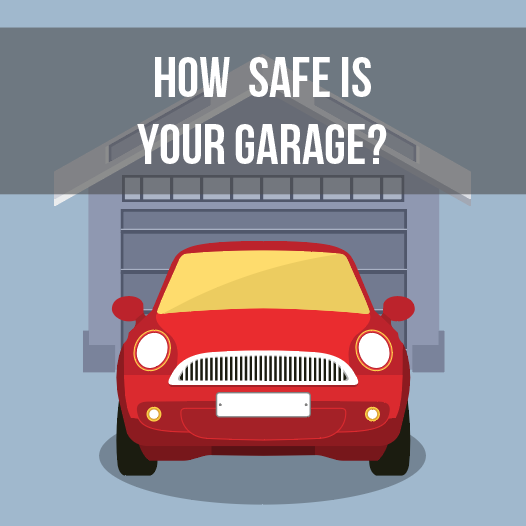Is the garage the most dangerous room in your home? It’s easy to forget that the garage, whether it is attached the house or sits separately, is still part of the property. The National Fire Protection Association reports there were 365,500 house fires in 2015 – it’s guaranteed a certain percentage of those started in the garage because people tend to misuse the space.
Home risk management is about controlling common dangers but you must consider the entire property. Learn to do a regular assessment of your garage and find out what might be putting your family at risk. Consider these four extreme garage dangers that you may have overlooked.
1. Fire Hazards
Start by making an inventory of everything stored in the garage and look for potential fire hazards, especially combustible chemicals, these include:
- Fertilizer
- Paint thinner
- Pesticides
- Gas cans
The U.S. Fire Administration recommends you remove all combustibles from the garage and put them in a well-ventilated shed away from the house. If you use the garage as a workshop to paint cabinets or furniture, store the can aerosols and solvents in the shed for safekeeping. Also, properly dispose of any chemical you don’t need around the house.
Here are some changes you can make in the garage that add an extra layer of fire protection:
- Have the walls and ceiling evaluated by a professional. You might need to replace the material with something fire-rated like Type X fire rated gypsum. This is essential if there is a living space above the garage or if the garage attaches to the house.
- Install a self-closing and self-latching fire-rated door, as well.
- Remove any pet door that goes into the house. If there is a fire in the garage, the pet door allows it to spread easily.
- Place an assessable fire extinguisher in the garage. Look for one that is Class B/C, so you can use it to fight most kinds of fires including those caused by flammable liquids like gas.
- Install a heat alarm in the garage. This is different than a smoke alarm. A heat alarm signals if the temperature in the garage rises to a dangerous level.
Check the garage for potential electrical problems like overloaded outlets. Avoid using extension cords for appliances there and install the lowest recommended bulb wattage in the light fixtures.
2. Carbon Monoxide
Carbon monoxide is a real danger when the garage is attached to the house. Exhaust can build up quickly in a small space. Any opening between the garage and house is a potential leak. Examine the joints on the adjoining wall looking for spaces that might allow the gas to seep into the house including under the connecting door.
There may be no way to keep the carbon monoxide completely out, so consider installing CO detectors on every level of your home. Establish a rule for all drivers in the family to follow, as well. Never run the car in the garage even if the garage door is open.
3. Avoid the Clutter
Clutter is a danger for many reasons, so get the garage organized to make it safer for everyone. Separate items your stored in your garage, such as:
- Garden tools
- Auto supplies
- Holiday decorations
- Tools
Once you’re done sorting, go through each group to figure out what is trash, what can be donated and what you need to keep. Dispose of what you can by either giving or throwing items away and then come up with an organizational plan for the rest.
You might need to add some storage solutions to your garage to keep it free of clutter. These can include, a peg board for the tools, shelving units for the decorations, a work table for your auto supplies, and a cabinet for the garden tools
Whatever it takes to keep your stored items neat and off the garage floor. This will also allow you to see when the floor needs painting or repair. It will keep you from covering up dangerous problems like oil spills. As you develop your garage organization plan, make sure to keep stored items away from any appliances like the clothes dryer or hot water heater.
4. Security
Home intruders love houses with attached garages because they offer access that is easy to ignore. It doesn’t take much to secure the garage and close off that access, though. It’s more common sense than anything else, for example:
- Make sure all entryways have locks. Seems straightforward enough but it is easy to take at least one door for granted, especially the one that connects the house to the garage interior. Don’t assume that door is safe just because the big garage door is locked and secure. What about windows in the garage or the back door? Are they locked up tight, too? Your garage is the first place a burglar will look for an access point.
- Don’t leave the garage remote in your car even if you hide it well. They are easy to find and provide an intruder a way into your home, or at least into your garage where there might be bikes, expensive tools or a gun locker.
- Reset the access code on the garage door opener if you do lose a remote. You can also install an opener with a rolling system that changes the code each time it is used.
- Unplug your garage door opener when you are away from home on a trip.
How much attention have you given the garage lately? It is more than just the place where you park your car. Make this year’s home project to increase the value of your Pittsburg property by rehabbing the garage to make it safer and more organized. Give us a call to find the right garage organization solutions for your home.

